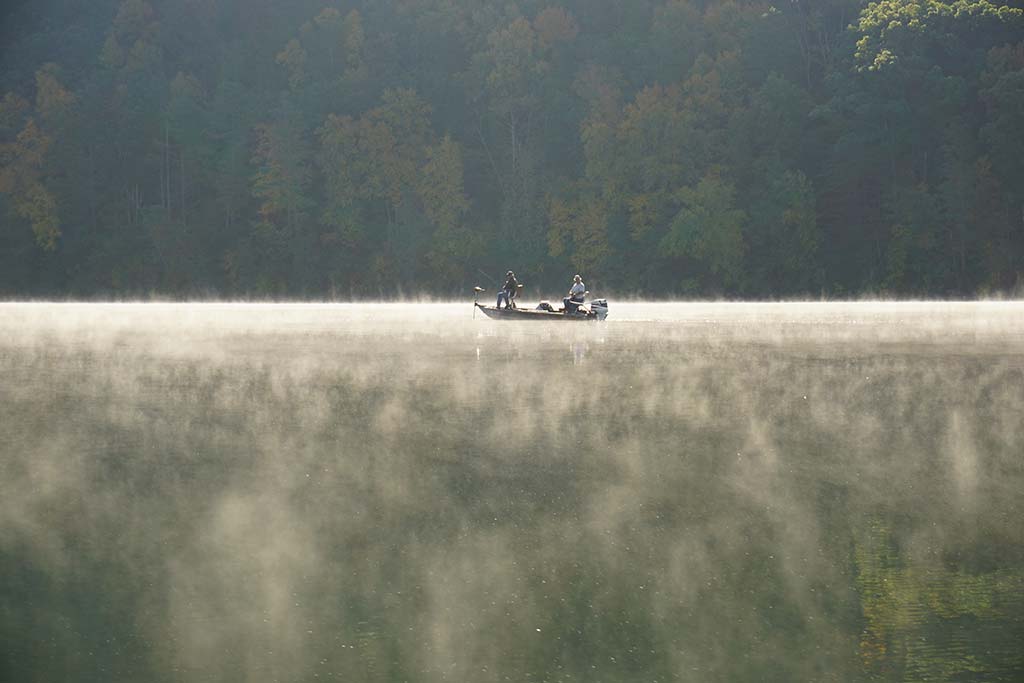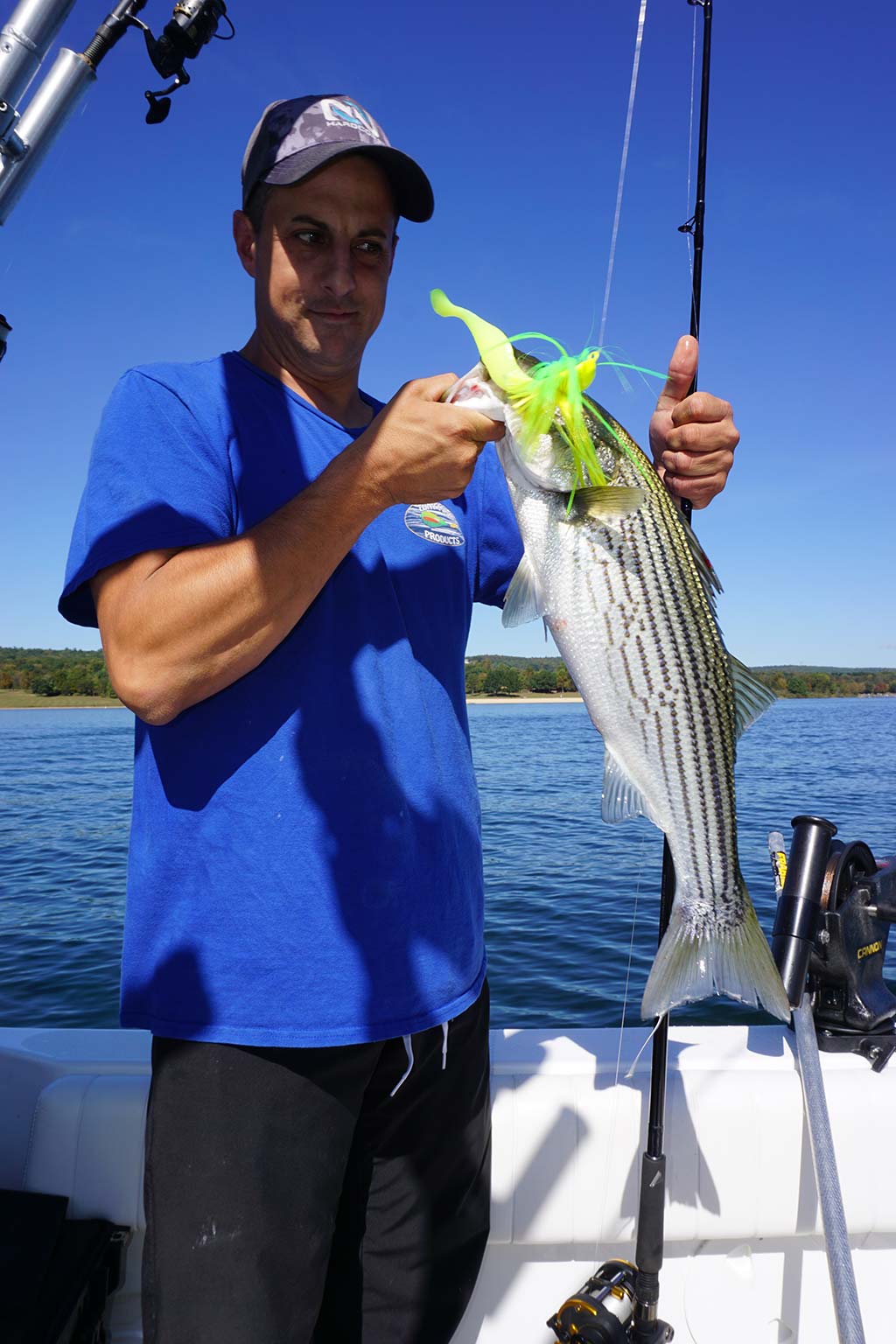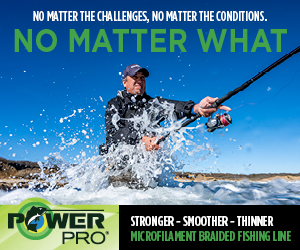
Head west in search of striped bass with the Pocono Outdoors Guy.
If you read the January edition of The Fisherman you probably saw my article called Go West – Stripers on Ice. While standing around a hole in the ice waiting for the tip-up to get knocked down may not be everyone’s cup of tea, the idea of pure-strain striped bass in a freshwater location must surely appeal to others. And truth be told, mid-summer is one of my favorite times of year for hunting big, inland stripers.
Yes, I do mean inland stripers and not the hybrid (white bass and striper mix), or holdover river fish that migrated up from the salt and stayed a while, but stocked pure strain freshwater stripers.
Here in the Pocono Mountains of Pennsylvania, my passion is getting on to those big deep freshwater lakes and targeting big, true blood striped bass. So what exactly is a big freshwater striper, you ask? On my home lake of Beltzville in Carbon County, PA, the lake record is 46 pounds.
A question I get quite often from coastal striper fishermen is “How do you fish for freshwater stripers?” My answer is always the same, “How do you fish for them in the saltwater?” There are many similarities between the saltwater striper and the pure-strain freshwater striper, and a few differences. But with all of us, from the mountains to the oceans, holding that 50-pound threshold in mind for trophy striper status, the best place to start is always the migration.

Stripers On The Move
“George, you just said these are landlocked stripers, how can they migrate?” Another good question. Every spring, saltwater anglers are glued to the internet pouring over those infamous heat maps of the spring striper migration as fish move up the coast to their spawning grounds; but those heat maps are more like where the fish have been a few weeks ago rather than a where to fish right now. So, just like in saltwater, we have to do our own homework in order to find success. I will tell you, there are no heat maps or detailed fishing reports on these freshwater lakes; in fact you will find most fishermen tight-lipped about what and where they are catching. But make no mistake, these fish also do a little bit of migrating!
Freshwater stripers just like their saltwater siblings will chase baitfish back up into those shallow feeder creeks and streams as spring approaches and water temps begin to warm. As with most fish, find the bait, find the fish. Only we are not looking for giant pods of bunker, most lakes have a healthy population of alewives or some even gizzard shad. Great forage for these healthy stripers, so look for the bait.
One of the most explosive and fun ways to catch stripers is when they blitz. Scenes have played out on local mountain lakes just as if it were Montauk or Raritan Bay. Always keep a casting rod ready if you are fishing from boat. Unfortunately, most blitzes occur too far from the bank for most shore fishermen. It is good to have a 4-inch or so popping plug ready, something weighted for casting distance. A lure landed in the middle of this frenzy with have a taker with only a few twitches of the rod in most cases. These tend to be smaller schooling fish in the 3- to 5-pound range, but there is always that chance of something much larger.
If not a popper, I will often have a swimbait, like a “Searchbait” at the ready, so even if the school decides to run deep after the blitz, I can still seek them out with a jig. Chasing “schoolies” is a great early morning/late afternoon strategy. – George “The Pocono Outdoors Guy”
The need to breed is in their blood as well, so even if conditions for successful breeding are not present, most fish will still make a spawn run. I have seen fish on this “spawn run” back in in shallow creeks in no more the two feet of water! They will absolutely make the attempt to breed. I have heard both sides of the argument that stocked fish cannot spawn, but others say it is possible. Maybe a marine biologist can help us settle this debate!
Just as many anglers do out front on in the bay, dragging mojos and bunker spoons are very productive in the big striper lakes of Pennsylvania. You will get a few funny looks from a few anglers as you rig up a Maja #3 spoon to the line, but you need to remember, these are the same fish as in the salt. They are just captive in a freshwater environment; and we use many of the same tactics you know from the salt, with a few adjustments.
The phrase Match the Hatch holds true here in Beltzville as well. Dragging a full sized 16-ounce mojo around or a big old Maja #4 will catch a nice striper, but remember that while there are big 30- to 40-pound stripers in the lake – and I hope to prove soon of the 50- to 60-pounders too, they are fewer in numbers than the huge biomass of breeding schools moving up the coast. Secondly, you will not find many bunker swimming around those lakes, they are feeding on much smaller baitfish, so downsizing is critical.
Tony Maja marketed a 3-ounce casting mojo that is perfect for trolling these inland lakes. It is more presentable and familiar in size to the fish population. On the bunker spoons, I usually downsize to a #1 or #2, to more closely mimic the bait in the area.

By Boat Or Bank
Trolling depth is extremely critical, water temps mid-summer can push surface temps into the mid/high 80’s. Far too hot for any cool water fish like stripers to spend any time hanging around. For that reason we need to fish the thermocline which is a point where the warm surface water floats on top of the cool water below. Depending on the lake, temp on the surface, etc., this can usually be found between 20 to 25 feet down. A very sharp drop in water temperature can be found at this level, and it is a difference of water in the 80s to high 60s or low 70s, right in the comfort zone of those stripers. They will cruise this depth searching for any bait they can find. Lures trolled just above this level work best, as fish look “UP” for prey, avoid going too deep as your presentation will run right underneath them without being noticed. Pay attention to large points near deep water, keeping lures in that strike zone.
Many anglers fishing from shore in the bay or surf will use a variety of fresh or cut bait. Bloodworms, surf clams, bunker, and the like. Those choices are pretty hard to find in a local Pennsylvania mountain tackle shop. So we had to look at other options. Chicken livers have been substituted for bloodworms and surf clams. Yes chicken livers! Think about it, a few big livers on a 9/0 circle hook is just like a big ball of bloodworm or surf clam, a bloody mess of protein on a hook! Sure you may end up with a big old catfish instead of a striper, but that isn’t so bad either in terms of a tug on the line.
Beltzville State Park and launch ramp is located at 2950 Pohopoco Drive in Lehighton, PA. For park information call 610-377-0045
Tackle & fishing Licenses
Carols Bait Shop
2950 Fairyland Rd
Lehighton, PA 18235
Wacky Worm
1222 Interchange Road
Gilbert, PA 18331
Accommodations
Country Inn & Suits
1619 Interchange Road,
Lehighton, PA 18235
Hampton Inn Lehighton-Jim Thorpe
877 Interchange Road,
Lehighton, PA 18235
Live or cut bait is a different story as well. Again, you won’t find a flat of bunker in any shop near these lakes, however many anglers fish the spring shad run on the Delaware River. This is a great source of bait for the coming season. Large chunks of frozen shad on a fish-finder rig are and excellent strategy for summer stripers. I have also used smelt that you can purchase at any grocery store, you can get a few pounds of cleaned smelt for just a few bucks. Of course live bait is effective and many shops will carry extra jumbo striper shiners, although they will cost you about a buck and a half per bait, but they will get the job done.
Live trout is another favorite, you can get these from most hatcheries. Please be sure to keep your receipt and check the regulations in your area about using hatchery fish for bait! Live baits work best fished in deeper water with a sliding sinker, or free lined in deeper water near structure such as a dam.
I always tell folks to “use what you know!” Half the battle in fishing is confidence. If you are confident in your tactics and strategy, you will be successful. Do not leave your saltwater tackle box at home when you visit these lakes, use what you know works. But also explore new ways of getting on these amazing freshwater fish.
Let’s get on ‘em!
Better known as “George The Pocono Outdoors Guy,” the author is a regular, weekly contributor to The Fisherman’s New Jersey, Delaware Bay video fishing forecasts, and is producer/host of “Pocono Outdoors Guy” and “The Weekend Round-Up” on YouTube. Find George online at PoconoOutdoorsGuy.com.




